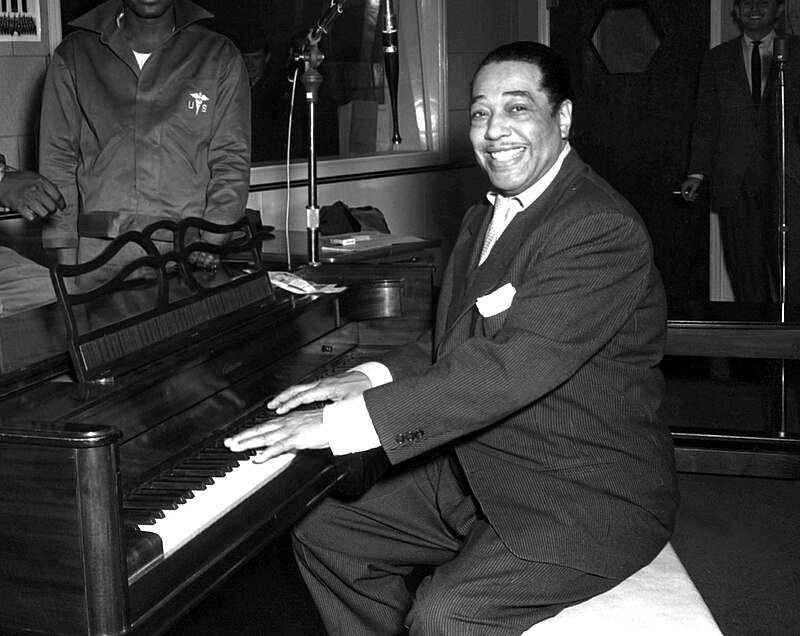***This blog was originally published on November 20, 2020.
This post features the Duke Ellington stamp from the United States in 1986. It was the first US stamp featuring a jazz musician. Learn more about jazz musicians on stamps on this page. It was only in 1940 that the United States made stamps featuring musicians. The five men are John Philip Sousa, Stephen Foster, Victor Herbert, Edward MacDowell, and Ethelbert Nevin. You can read my thoughts about this set of stamps on this blog post.
These four men were all white, which in terms of American music really misses the boat. So much of the great American music was due to Black musicians. Even with the rule that an individual must be dead for ten years before they appear on a postage, there were plenty of great African-American musicians that would have been eligible for inclusion on stamps in 1940.
Black Musicians on U.S. Stamps
The first Black musician to appear on a postage stamp was W. C. Handy, who was on a postage stamp in 1969. But it really took until the 1980s before African-American musicians started to appear on a regular basis. Scott Joplin, the great ragtime musician and composer, appeared on a stamp in 1983. Another turn-of-the-century composer, as well as Civil Rights Leader, was James Weldon Johnson. He wrote hundreds of songs for Broadway and also penned the words to the song “Lift Every Voice and Sing” (often called the Black National Anthem). Johnson appeared on a 1988 stamp, a full fifty years after his death.
Duke Ellington was on a rather beautiful stamp from 1986. It was even made fairly quickly after Ellington was eligible to appear on a stamp. According to the then rules, in order to be eligible to appear on a stamp, a person had to be dead for at least ten years. Ellington died in 1974, so the 1986 stamp was soon after his eligibility.
The Musician

VIRIN: HA-SN-99-00410 (cropped), Public Domain
Edward “Duke” Ellington has to be considered one of the greatest American musicians to ever live. He wrote (or co-wrote) hundreds of songs, many of which are ranked among the best loved jazz standards ever written. Some of his hits include “It Don’t Mean A Thang (If It Ain’t Got That Swing),” Sophisticated Lady,” “Caravan,” “Take the A Train,” and “Black, Brown, & Beige.”
Ellington was also a famed bandleader and performed with many of the greatest jazz and popular singers and instrumentalists beginning in the 1930s through his death in 1974. His appearances at the Cotton Club in Harlem were legendary and became a tourist destination within New York City, and his touring and appearances on television helped to break down racial barriers. He truly was a great American musician and more than deserving of recognition on a postage stamp. You can learn more about him on this post from the Songwriter’s Hall of Fame.
The Stamp

Scott # 2211
The Ellington stamp dates from April 29, 1986, which would have been Ellington’s 87th birthday. Jim Sharpe of Westport, Connecticut was the designer of the issue. It features the musician in profile with a piano keyboard in the background. Over a five year period predating the release of the stamp, fans of Ellington had bombarded the postal service with more than 50,000 requests for a stamp to honor the musician. When it was finally released, due to his popularity, the postal service made 130 million copies of the stamp. You can read more about this stamp on this blog from the Smithsonian or on this page from Google Arts & Culture.
A Beautiful Cachet

I also own a beautiful cachet featuring the Duke Ellington stamp. In philatelic terminology, a cachet is an envelope (or postcard, etc.) that has a printed, stamped, or otherwise decorated design that celebrates the stamp or the date of cancellation. Many cachets are made to celebrate the first day issues of stamps. The Ellington cachet is above is such a first day cover.
This cover is very handsome, featuring Ellington playing a white grand piano. This main design sits in the lower left corner facing to the right, it creates a balance, or bookend, with the Ellington depiction on the stamp in the upper right corner that faces left. Behind the piano are three standing jazz musicians in matching coats playing the saxophone, clarinet, and trumpet.
The cachet is by the artist Fred Collins. He began making hand decorated cachets in 1978 and has become well known throughout the philatelic community. Collins specializes in making new designs for each USPS stamp issue and limits the production to a few hundred of each design. You can see more of his work on his website.
Finally, make sure to listen to some of Duke Ellington’s music. Here is one of my favorite Ellington pieces, “It Don’t Mean a Thing.”


